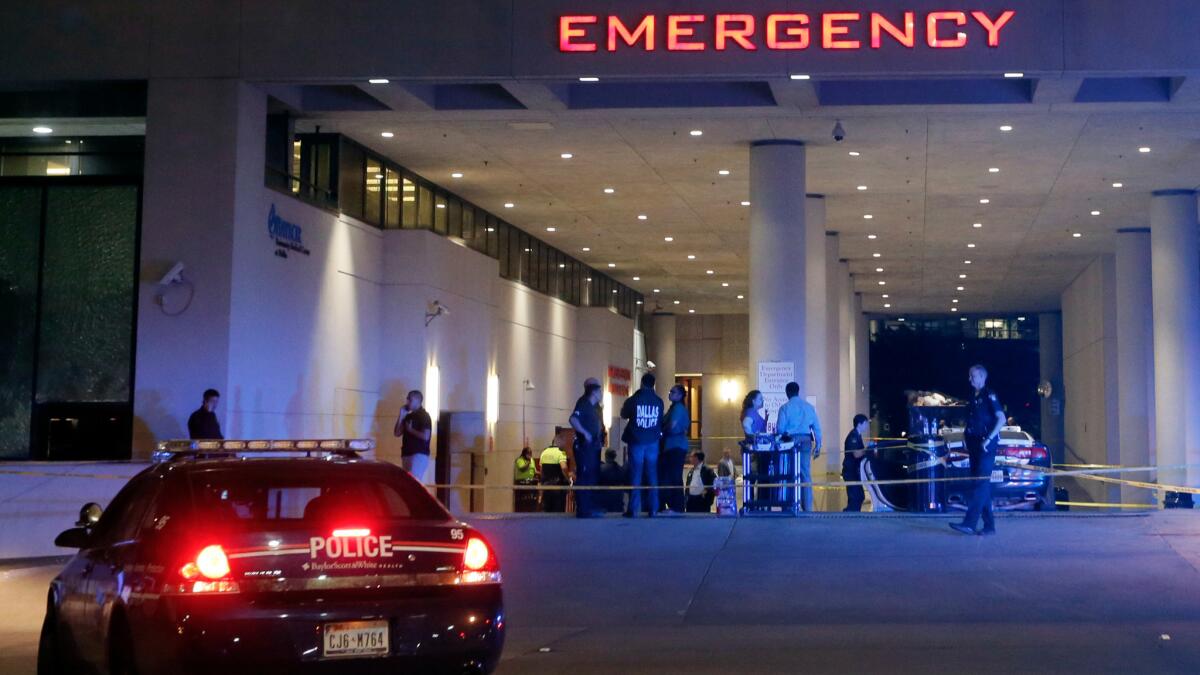Editorial: Dallas shooting puts U.S. at a crossroads. Will we address race and criminal justice or allow violence to fester?

- Share via
What happened in Dallas is unambiguously awful — unforgivable, indefensible, tragic. There is no moral calculation that can justify the killing of five police officers in cold blood. Police officers put their lives at risk to protect communities. They go where the rest of us don’t dare. They run toward danger when the rest of us run away. On Thursday, these five officers were doing their jobs, patrolling a peaceful evening protest, when they were killed without warning. That’s heartbreaking and unfair.
But at the same time, the fact that a deranged sniper (or perhaps two or three or four) went on a shooting rampage does not mean — and should not be cynically used to suggest — that the people who were demonstrating in Dallas had no cause for protest. Americans must be able to hold those two ideas in their heads simultaneously: that the actions of the sniper or snipers were reprehensible and that those protesting the police shootings of African Americans in Minnesota, Louisiana and elsewhere have legitimate grievances.
If race is the great unfinished conversation in American society, it is criminal justice — and policing in particular — that is at the cutting edge of that discussion, a subject that separates blacks from whites perhaps more than any other. Until recently, when Michael Brown, Freddie Gray, Eric Garner, Tamir Rice, Ezell Ford and others became household names, white Americans were often too oblivious to African American anger about police brutality and police shootings.
Yet that anger is not 2 years old and did not begin when Brown was killed in Ferguson, Mo., in 2014. It is 50 years old, 75 years old, 100 years old and more. Angelenos should know this; they should remember that the 1992 riots in Los Angeles stemmed from the LAPD beating of Rodney King, and that the 1965 Watts riots began with the California Highway Patrol stop of an African American driver that turned violent.
Today, the subject remains raw and painful for African Americans and, increasingly, for whites. The videos that millions of people watched this week were horrifying, scary and depressing. Of course, Americans were upset watching Philando Castile bleed to death in his car after being shot by a police officer in Minnesota in front of his girlfriend and her child. Of course they were angry watching officers shoot Alton Sterling to death in Baton Rouge, La., as he lay on the ground. These graphic, violent videos, like others that have become public in recent years, seemed to many viewers to suggest an almost casual disregard for African American life on the part of the police. Did police really have to shoot Sterling if he was, in fact, already pinned down? Can it be true that Castile was killed while reaching for his wallet to produce his driver’s license, as his girlfriend says he was instructed to do?
It’s nearly impossible to tell from any single video who was right or wrong or whether a shooting was justified. To understand the severity and nature of our national policing problem and to put it in context, what’s needed is more analysis, data and information. How many people are being killed by the police? How many of them are young men? How many are unarmed? How many are African American? Why are they being shot and by whom? We need intelligible data before we can fully understand whether we’re facing a training problem or a racism epidemic or a gun-control problem or a crime problem or a trigger-happy cop problem. It is entirely outrageous, nearly two years after Ferguson, that police agencies around the country are not uniformly required to make this information available to the federal government and the public.
Instead, the discussion must rely on informal statistics. The Washington Post, for instance, has been tracking the numbers as best it can. That newspaper reported this week that police shootings around the country had increased from 465 in the first six months of 2015 to 491 for the same period in 2016, and that blacks continued to be shot at 2.5 times the rate of whites (although more whites are killed by police overall than blacks).
President Obama took exactly the right tone twice this week. First, on Thursday, he noted that Americans should be troubled by the recent shootings by police in Minnesota and Louisiana, which he called “symptomatic of a broader set of racial disparities that exist in our criminal justice system.” He explained that there was no contradiction between supporting law enforcement and recognizing its mistakes, biases and problems. Then, on Friday, he denounced the “vicious, calculated and despicable” attack on the police officers in Dallas and vowed that anyone involved would be held accountable.
The United States is at a crossroads, facing an epidemic of anger, a divided populace and another skirmish in our long national struggle with race. How will we respond? Can we address the inequalities and disparities that President Obama called to our attention, or will we ignore them at our own peril?
Follow the Opinion section on Twitter @latimesopinion or Facebook
ALSO
5 arguments against gun control — and why they are all wrong
Why is the United States such a gun-happy society? It’s time to find out
House Democrats keep up gun control push as they return from recess
A cure for the common opinion
Get thought-provoking perspectives with our weekly newsletter.
You may occasionally receive promotional content from the Los Angeles Times.






